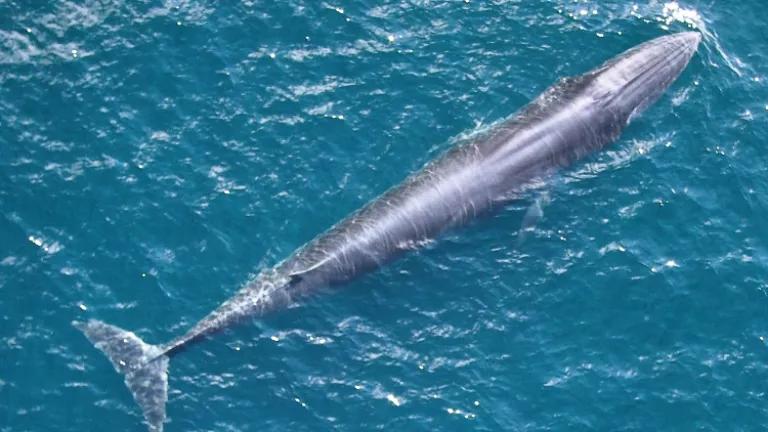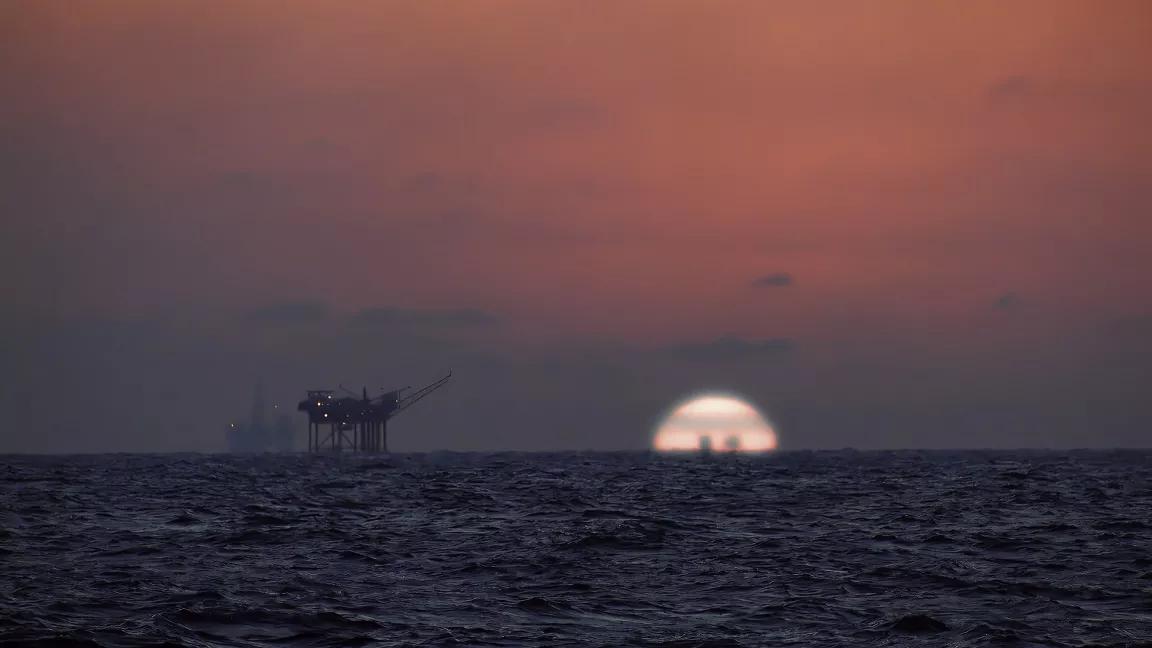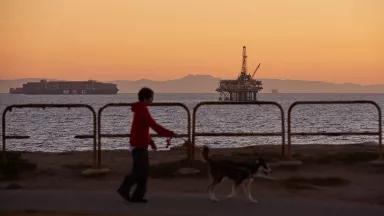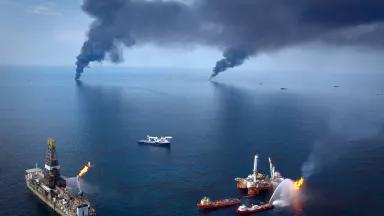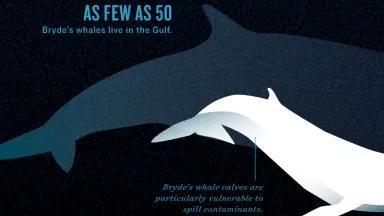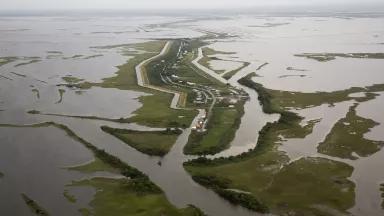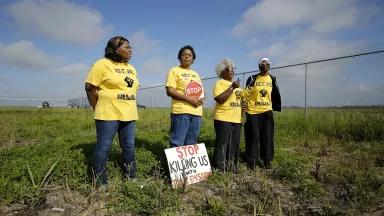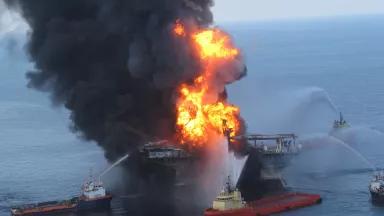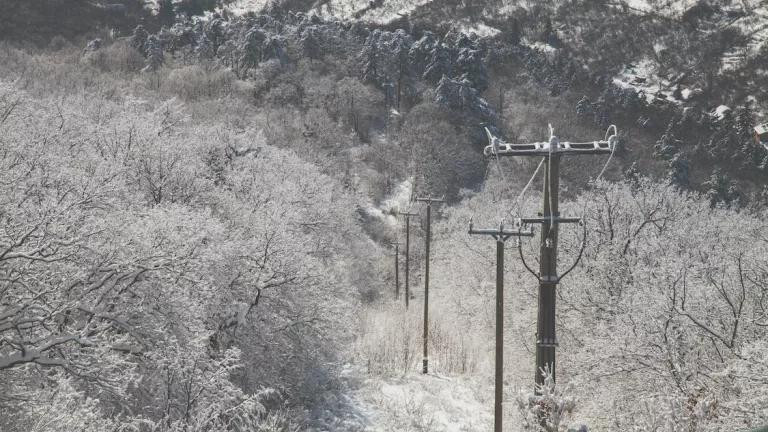Biden Administration Expands the Gulf's Waters to Oil and Gas Drilling
The region's communities and marine life will continue to be exposed to the catastrophic risk and ongoing damage of these inherently hazardous industrial operations at sea.
The Biden administration announced plans last week to expand the Gulf of Mexico waters available to oil and gas drilling as part of the new five-year leasing plan that will take effect in 2024.
The plan calls for a historically low number of lease sales. But let’s be clear: Oil and gas companies already hold Gulf of Mexico leases covering more than 12 million acres. That’s enough to blanket half the state of Indiana—and to produce oil and gas at current rates for decades. Exposing even more of the these irreplaceable waters, home to a wealth of marine species like the highly endangered Rice’s whale, to the risk of a BP oil disaster–style blowout makes no sense.
It’s time to break, not deepen, our dependence on the fossil fuels that are driving the climate crisis. It’s time to make federal waters part of the climate fix, not part of the problem. It’s time to protect our oceans, marine life, and coastal communities from the hazard and harm that comes from drilling for oil and gas at sea. And it’s time to end the devastating health toll Gulf communities suffer from the production, refining, and export of dangerous fuels. That’s the message coming directly from the region.
Gulf waters have never been hotter. Rising seas are swamping the Gulf coast, home to this country’s first officially recognized community of climate refugees. And Louisiana is suffering some of the worst heat, drought, and wildfires in the state’s history. These are direct consequences of the climate crisis caused by burning gas, oil, and coal. The science is clear: We must phase out these dangerous fuels in favor of cleaner, more sustainable options. Doing so is the economic play of our lifetime, a shift that is already driving investment, spurring innovation, and creating tens of thousands of jobs.
Across the Gulf region, the costs are rising and the dangers are mounting from the climate crisis by the day. In what the local press dubbed the “summer from hell,” high temperatures and humidity combined to make it feel like 120 degrees in New Orleans in August.
Wildfires have burned more than 60,000 acres in Louisiana, which has experienced some of the worst fires and one of the worst droughts in the state’s history, even as saltwater intrusion from rising seas threatens precious freshwater supplies, forcing the state to barge in fresh water daily. “Our state has never been this hot and dry,” as Louisiana governor John Bel Edwards put it, “and we have never had this many fires.” In August, average water temperatures in the Gulf topped 88 degrees Fahrenheit. That’s the hottest on record and 2.6 degrees above the 30-year average.
About 91 percent of the warming caused by climate change is absorbed by the earth’s oceans.
Due to that additional heat and the periodic El Niño that further warms parts of the Pacific Ocean, 39 percent of the world’s oceans are experiencing marine heat waves, like those threatening coral and other life in the Gulf, Caribbean, and Atlantic waters.
A rapid rise in sea level is speeding the loss of coastal lands in Louisiana, at a time when billions of dollars are being invested to try to save coastal wetlands that have been irreparably degraded by the oil, gas, and pipeline industry. Since 1932, Louisiana has lost more than 2,000 square miles of coastal wetlands, enough to cover the state of Rhode Island. That’s a fourth of the state’s coastal lands. The state continues to lose an area the size of a football field every hour and a half.
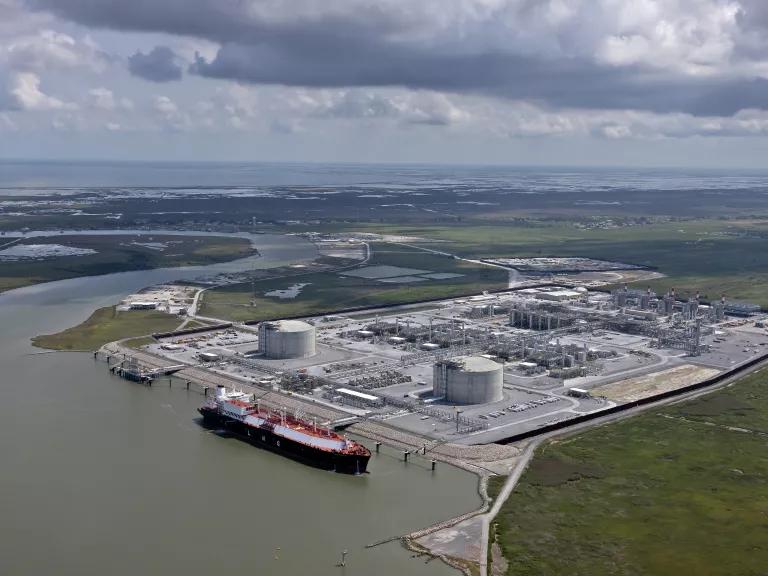
Wetlands surround the Venture Global's Calcasieu Pass liquefied natural gas export facility in Cameron Parish, Louisiana.
Julie Dermansky for NRDC
The oil and gas industry is directly responsible for much of this loss—36 percent, the U.S. Geological Survey estimates; up to 59 percent, the U.S. Department of Interior has reckoned—because it has opened some 10,000 miles of wetlands to forces of the open sea by dredging out cuts to lay pipelines and slicing out canals for the passage of oil and gas service vessels. The disappearing coastal wetlands are the state’s first line of defense against flooding and storm surge, like that caused two years ago when Hurricane Ida left 87 dead across the Gulf region and caused $75 billion in damages.
Beyond the escalating climate hazard and harm, offshore drilling and oil and gas production subjects Gulf waters, marine life, and coastal communities to the risk of a catastrophic blowout, such as the Deepwater Horizon disaster in 2010; tanker spills, such as the Exxon Valdez disaster in 1989; and pipeline failures, such as the one that dumped 126,000 gallons of crude oil off the beaches of Southern California in 2021.
Parts of the Gulf have yet to fully recover from the 2010 Deepwater Horizon oil spill, caused by the blowout of BP’s Macondo well in mile-deep water some 50 miles off the coast of Louisiana. The disaster killed 11 workers aboard the Deepwater Horizon drilling vessel. In the 87 days it took to seal the well, it gushed some 4 million barrels of crude oil into one of the richest marine ecosystems in the world, the source of 15 percent of the nation’s shrimp, oysters, and other seafood, valued at nearly three-quarters of $1 billion a year.
Oil from the blowout killed countless brown pelicans, dolphins, endangered sea turtles, and other species, from the smallest grass shrimp to the largest whale. It fouled more than 1,300 miles of shoreline—including habitat for more than two dozen endangered and threatened species of birds—and covered, at one point, 15,300 square miles of ocean waters, enough to cover the states of Maryland and Delaware combined.
The oil killed about one in five of the world’s remaining Rice’s whales, one of the most endangered whales on the planet. Only about 50 such whales remain, and their narrow strip of habitat lies directly in the area now available for oil and gas drilling under the new five-year lease plan. And yet, the new plan provides no protection for the species, electing, unconscionably, to punt the issue to the next administration.
Beyond the risk of catastrophic disaster, offshore oil and gas operations subject ocean waters, marine life, and coastal communities to ongoing harm and daily degradation that are a routine part of the industry’s impact. In 2021, there were 14 spills of oil or industrial chemicals from oil and gas operations in the Gulf, along with 117 fires, 4 explosions, and other accidents that killed 2 workers and injured 164.
The industry has abandoned some 14,000 wells without properly plugging and sealing them, along with some 18,000 miles of abandoned pipelines, leaving them scattered across the Gulf floor where they can leak methane—a powerful greenhouse gas—and oil, sometimes for a decade or more.
Nor does the harm end at the water’s edge. Refining Gulf fuels imperils the health of Louisiana communities, especially those with low-income residents and people of color. Nearly 150 oil refineries, petrochemical plants, and related industrial facilities are concentrated along the Mississippi River in southern Louisiana, an area referred to as Cancer Alley due to the risks and damage to health inflicted on those who live there.
The Gulf region and its people have been sacrificed to the destructive U.S. dependence on oil and gas for far too long. Expanding the amount of Gulf waters, marine life, and coastal communities exposed to the catastrophic risks and ongoing harm this industry inflicts is the wrong direction—for the country and for the region.
It’s time to break the country’s reliance on oil and gas and all the damage and danger it brings, not lock the country into decades more of a deepening dependence on these dirty and destructive fuels.
Only 50 Rice’s whales are left on the planet.
Tell Secretary of Commerce Gina Raimondo to protect these imperiled whales from extinction!
